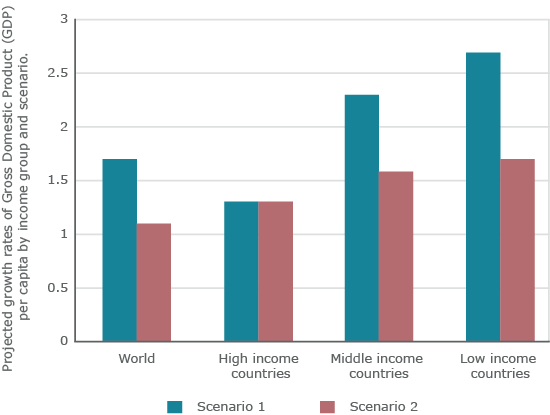Undoubtedly, climate change impacts modern societies in very different ways. In this regard, further advances in climate change research can actually contribute to a better understanding of not only the complex interrelationship between climate and socio-economic conditions of populations, but also of macroeconomic behaviours focused on human capital dynamics. Jesús Crespo Cuaresma develops a model that projects per capita income in the very long run for 144 countries, a potential instrument that could be used to measure the impact of climate changes at the global level. This model is also an important input for design policy responses linking human capital dynamics, such as peoples’ educational attainment and populations’ age structure, to economic growth.
When economic growth strongly depends on human capital developments
Crespo uses two different scenarios (Figure 1) to illustrate how crucial human capital dynamics are in shaping future growth rates of per capita income. The first refers to a world where the average income tends to converge and inequalities between and within countries are reduced. In the second scenario, there is a polarised distribution of educational attainment that leads to greater inequalities. In both scenarios, the positive effect of human capital development on productivity and innovation drives the projected growth rates between 2010-2100. However, the degree of growth is higher in the first scenario (1,7%) than in the second (1,1%), especially among middle and low income countries.
Crespo also found that in the first scenario the income per capita tends to grow much more on average during the period 2010-2100 in countries classified as middle (2,3%) and low (2,7%) income economies than in those classified as high income economies (1,3%). In the second scenario, the growth rates of per capita income are lower and not sufficient to reduce the gaps between countries maintaining high levels of inequality.

Figure 1. Projected growth rates of Gross Domestic Product (GDP) per capita by income group and scenario.
This Population Digest has been published with financial support from the Progress Programme of the European Union in the framework of the project “Supporting a Partnership for Enhancing Europe’s Capacity to Tackle Demographic and Societal Change”.